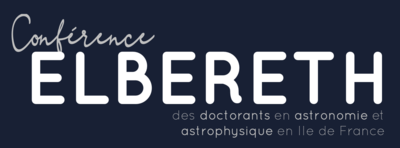The Event Horizon Telescope (EHT) collaboration released in 2019 the first horizon-scale images of the supermassive black hole M87*, dominated by a bright, unresolved ring. General relativity (GR) predicts that embedded whitin this images lie observable, thin, ring-shaped features produced by photons on extremely bent orbits: the "photon rings".
In a parametric framework of GR, the idea of...
The study of supernovae is an area of great interest in astrophysics. After their explosion, the supernova remnant (SNR) goes through different phases, dispersing its energy into the interstellar medium (Truelove & McKee 1999). At the end of its evolution, the shock behaves like a Taylor-Sedov blast wave. It is during this phase that the SNR may collide with other objects, such as molecular...
NOIRE (Nanosatellite pour un Observatoire Interferometrique Radio dans l’Espace) is an instrumental concept study. NOIRE aims to ba a very low frequency observatory. It will be an interferometer composed of a swarm of about 50 satellites. This instrument will enable to observe various objects and phenomena mostly unknown. Many scientific topics can be covered by NOIRE. This new type of...
SPHERE has been a high-contrast instrument on sky at the Very Large Telescope since 2014. It makes infrared images of young giant planets, circumstellar disks, and characterizes them by spectroscopy and polarimetry. The next upgrade of SPHERE aims at improving the exoplanet detection capabilities, in particular closer to the star. To achieve this goal, the adaptive optics system will be...
The projection factor, or p-factor, is a way to link the observed radial velocity of the atmosphere of the star to the velocity of the photosphere. It was introduced in the context of the Baade-Wesslink technique, to determine distances of pulsating stars. However, after almost a century of using the method and of efforts put in the calibration of this factor, results still seem to be...
Stellar magnetism still remains poorly understood : there is a huge variety of topology and magnetic phenomena which need to be characterized regarding the different stellar physical parameters such as the Rossby number.
The resulting magnetic activity is here use as a observable to improve our understanding of spot characteristics (area, lifetime...) and link these properties to the dynamo...

